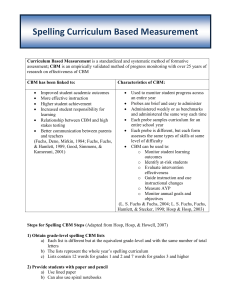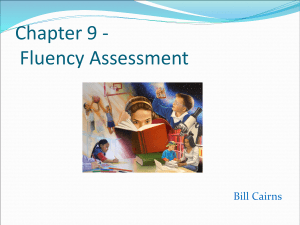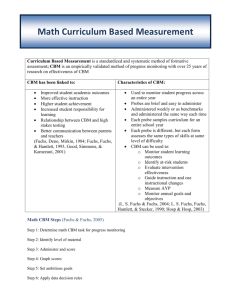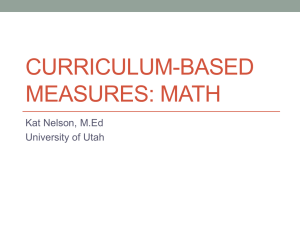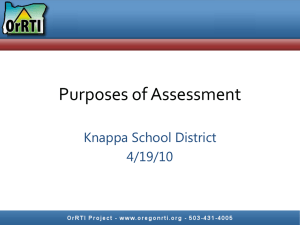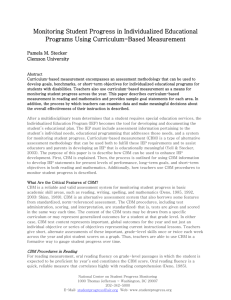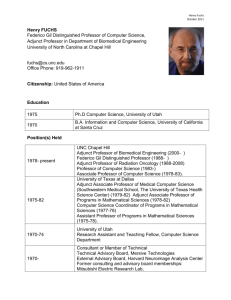Reading Curriculum Based Measurement
advertisement
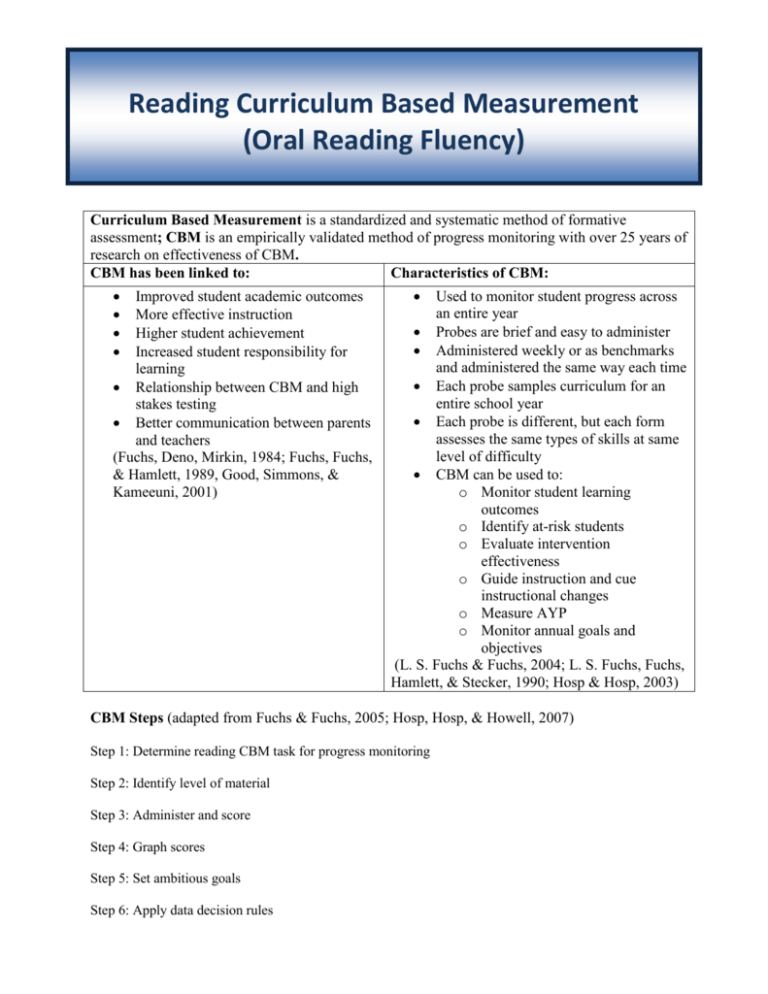
Reading Curriculum Based Measurement (Oral Reading Fluency) Curriculum Based Measurement is a standardized and systematic method of formative assessment; CBM is an empirically validated method of progress monitoring with over 25 years of research on effectiveness of CBM. CBM has been linked to: Characteristics of CBM: Improved student academic outcomes More effective instruction Higher student achievement Increased student responsibility for learning Relationship between CBM and high stakes testing Better communication between parents and teachers (Fuchs, Deno, Mirkin, 1984; Fuchs, Fuchs, & Hamlett, 1989, Good, Simmons, & Kameeuni, 2001) Used to monitor student progress across an entire year Probes are brief and easy to administer Administered weekly or as benchmarks and administered the same way each time Each probe samples curriculum for an entire school year Each probe is different, but each form assesses the same types of skills at same level of difficulty CBM can be used to: o Monitor student learning outcomes o Identify at-risk students o Evaluate intervention effectiveness o Guide instruction and cue instructional changes o Measure AYP o Monitor annual goals and objectives (L. S. Fuchs & Fuchs, 2004; L. S. Fuchs, Fuchs, Hamlett, & Stecker, 1990; Hosp & Hosp, 2003) CBM Steps (adapted from Fuchs & Fuchs, 2005; Hosp, Hosp, & Howell, 2007) Step 1: Determine reading CBM task for progress monitoring Step 2: Identify level of material Step 3: Administer and score Step 4: Graph scores Step 5: Set ambitious goals Step 6: Apply data decision rules Step 1: Determine reading CBM task for progress monitoring (adapted from Hosp, Hosp, & Howell, 2007) Grade Kindergarten Reading Task Letter Sound Fluency (LSF) Description Students identify the sounds each letter makes when shown a list of letters 1 Word Identification Fluency (WIF) Students read a list of common words Oral Reading Fluency (ORF) Students read passages and words read correctly are counted 2 3 4 and higher ORF ORF Mazes Students read a passage with blanks in place of words removed from the passage and choose a word to fill in the blanks. Words replaced correctly are counted. Note – this tip sheet will focus on oral reading fluency (ORF) because it is the most common reading CBM assessment used. For details on using early reading or maze CBM, see Hosp, Hosp, & Howell (2007). Step 2: Identify level of material (Capizzi & Barton-Arwood, 2009) 1) Administer ORF probes written at student’s current grade level 2) If there is a concern that a student is not reading at grade level: a. If student reads less than 10 words in one minute, use word identification fluency b. If student reads 10 – 50 words correct in one minute use passages at the next lower level c. If student reads more than 50 words correct in one minute, move to the next higher level, not to exceed the student’s current grade level d. Once you have determined the correct grade level of probes, use the same level for the entire year Step 3: Consistently administer and score 1) Obtain ORF CBM materials (adapted from Hosp et al., 2007) a) ORF passages (see below for resources to find passages) a. 2 copies of each passage (one for student & one for teacher to mark errors) b. Each passage should contain at least 200 words, be different but equivalent in grade level/difficulty, and represent the reading skills that are expected by the end of the school year b) Stop watch or countdown timer c) Directions to administer the probes d) A graph to plot the data 2) Administer with individual students a) Administer 3 equivalent probes the first time in one session (recommended) or across days b) The median score will be first data point on graph 3) Use the same directions for each administration. There are multiple versions of ORF directions. Select one and consistently use it for each administration across the school year. The following script is one option (Hosp et al., 2007; p. 37): Give the student a copy of the reading passage. Hold the teacher’s version where the student cannot see what the teacher is writing (e.g., put it on a clip board). Say, “I would like for you to read this story aloud for me. Please start here (point to the first word on the student’s copy) and read aloud. This is not a race. Try each word. If you come to a word that you do not know, you may skip it and go to the next word. You may start when I say ‘Begin.’ You may stop when I say ‘Stop reading.’ Do you have any questions?” Set the timer for 1 minute. Follow the teacher’s copy and make an X on any words read incorrectly. At the end of 1 minute, say, “Stop reading” mark the last work the student read with a slash (/). 4) Scoring (Hosp et al., 2007) a) Count the total number of words attempted. Count the errors. Subtract the errors from the total number of words attempted to get words read correctly score (WRC). b) If a student finishes in less than one minute, note the number of seconds and use this formula: number of words read correctly divided by number of seconds to read the passage X 60. c) To score as correct Words read correctly within context of sentence. Repetitions Self-correction Dialect Inserted words are not scored as correct or incorrect d) To score as incorrect Mispronunciations Word substitutions Omissions Hesitations for more than 3 seconds Reversals e) Other scoring Hyphenated words are counted as two words Abbreviations and numbers are counted as words and must be read correctly Do not count a skipped row as errors Do not correct a student when a word is misread Step 4: Graph scores (for progress monitoring purposes) (Fuchs & Fuchs, 2005) Two options: 1) Paper and pencil graphs a) Vertical axis - include the range of scores of all students in the class from zero to the highest score. Horizontal axis - include the number of weeks of instruction, allowing for data to be entered one to two times per week b) Make a template of the above and one copy for each student 2) Chart Dog (www.interventioncentral.org): Web-based data storage and management 3) Commercial CBM materials (see below under Premade CBM Materials) Step 5: Set ambitious goals (Hosp et al., 2007) There are several options in goal setting: 1) Using benchmarks: Using the reading CBM Benchmarks table below. Determine the end of year benchmark (performance level), which is the spring score at the 50th percentile. Graph the three baseline scores and the end of year benchmark. Draw a goal line on the graph from the median baseline score to the end of year performance goal. Grade Percentile 1 90% 75% 50% 25% 10% 90% 75% 50% 25% 10% 90% 75% 50% 25% 10% 90% 75% 50% 25% 10% 90% 75% 50% 25% 10% 90% 75% 50% 25% 10% 90% 75% 50% 25% 10% 90% 75% 50% 25% 10% 2 3 4 5 6 7 8 Norms for Words Read Correctly (WRC) (AIMsweb, 2006) Fall Winter Spring 49 78 106 22 46 80 8 23 52 2 13 38 0 6 15 103 129 143 79 103 118 54 77 92 27 52 68 14 25 42 130 148 163 103 124 139 77 96 110 49 67 82 30 41 52 149 168 184 123 141 155 126 99 114 73 89 100 48 62 73 169 183 198 142 158 171 112 128 141 85 99 109 60 73 82 182 199 211 158 171 183 131 144 155 101 114 126 70 83 94 186 197 209 160 169 183 131 140 153 103 112 124 81 87 96 185 193 201 162 170 180 138 146 155 107 115 127 77 83 94 2) Using norms: Using the ORF CBM Weekly Growth Rates table and the formula to calculate the end of year goal. Graph the three baseline scores and the end of year goal. Draw a goal line on the graph from the median score to the benchmark. Initial median score + (growth rate x number of weeks of instruction) Example: 55 (initial median score) + (.8 [weekly growth rate] x 30 weeks) = 79 (goal) ORF CBM Weekly Growth Rates: Words Read Correctly (WRC) Grade Realistic Weekly Ambitious Weekly Growth Rates Growth Rates 1st 2 3 2nd 1.5 2 rd 3 1 1.5 4th 0.85 1.1 5th 0.5 0.8 th 6 0.3 0.65 Data from Fuchs et al. (1993) Step 6: Apply data decision rules See the table below: Making Decisions using CBM Data Look at the last 3 data points. If the data points are: Close to the goal line (all on the line, or some above and some below) All below the goal line All above the goal line Continue your instruction as implemented If your student has an increasing slope with gains at or near your aimline, then he/she is responding to your instruction - so keep doing what you are doing Change your instruction If at least 3 consecutive scores have fallen below the aimline, the student is not responding optimally to instruction. Try something new. Change your goal for the student and maintain your instruction as implemented If at least 3 consecutive scores are above the aimline, your instruction is very effective for the student and you can increase the goal for the student. How often should ORF CBM be given? (Hosp et al., 2007) 1) If you are using CBM for screening or benchmarking: three times a year (fall, winter, spring) a. Not recommended during first 2 weeks of school. Screening too early may inaccurately target students for more intensive instruction. 2) If you are using CBM for progress monitoring: own to two times a week for any student considered at risk based on norms or benchmark data. Resources to Find Probes (Hosp et al., 2007) Premade Reading CBM Probe Sheets AIMSweb www.aimsweb.com ORF and maze passages Cost for materials; graphing and data management available Dynamic Indicators of Basic Early Literacy Skills (DIBELS) https://dibels.uoregon.edu Free ORF passages; data management available Edcheckup www.edcheckup.com ORF and maze passages Cost for materials; graphing and data management available Monitoring Basic Skills Progress (PRO-ED) http://www.proedinc.com/customer/default.aspx ORF and maze passages Cost for materials; graphing and data management as well as computerized administration available Vanderbilt University http://kc.vanderbilt.edu/site/services/education/page.aspx?id=445 Cost for copying and postage Yearly Progress Pro (McGraw-Hill) www.mhdigitallearning.com Maze passages available Cost for materials; graphing and data management as well as computerized administration available Also see http://rti4success.org/progressMonitoringTools Other Resources National Center on Student Progress Monitoring http://www.studentprogress.org/ National Center on Response to Intervention http://www.rti4success.org/ The IRIS Center for Training Enhancements - http://iris.peabody.vanderbilt.edu o Classroom Assessment (Part 1): An Introduction to Monitoring Academic Achievement in the Classroom http://iris.peabody.vanderbilt.edu/gpm/chalcycle.htm o Classroom Assessment (Part 2): Evaluating Reading Progress http://iris.peabody.vanderbilt.edu/rpm/chalcycle.htm Intervention Central o http://www.interventioncentral.org/index.php/cbm-warehouse References AIMSweb. (2006). Oral reading fluency norms [Data file]. Available at http://www.aimsweb.com. Capizzi, A. C., & Barton-Arwood, S. M. (2009). Using a CBM graphic organizer to facilitate collaboration in reading. Intervention in School and Clinic, 45(1), 14-23. Fuchs, L. S., Deno, S. L., & Mirkin, P. K. (1984). The effects of frequent curriculum-based measurement and evaluation on student achievement, pedagogy, and student awareness of learning. American Educational Research Journal, 21, 449-460. Fuchs, L.S., & Fuchs, D. (2004). Determining adequate yearly progress from kindergarten through grade six with curriculum-based measurement. Assessment for Effective Instruction, 29(4), 2538. Fuchs. L. S., & Fuchs, D. (2005). Using Curriculum-Based Measurement for progress monitoring in math. Retrieved from www.k12.wa.us/SpecialEd/pubdocs/RTI/CBM_Manual_Math_9_29_05.pdf. Fuchs, L. S., Fuchs, D., & Hamlett, C. L. (1989) Effects of instrumental use of Curriculum-Based Measurement to enhance instructional programs. Remedial and Special Education, 10 (2), 4352. Fuchs, L. S., Fuchs, D., Hamlett, C. L., & Stecker, P. M. (1990). The role of skills analysis in curriculum-based measurement in math. School Psychology Review, 19, 6–22. Fuchs, L. S., Fuchs, D., Hamlett, C. L., Walz, L., & Germann, G. (1993). Formative evaluation of academic progress: How much growth can we expect? School Psychology Review, 22, 27-48. Good, R. H.III, Simmons, D.C. & Kameenui, E. J. (2001) The importance and decision making utility of a continuum of fluency-based indicators of foundational reading skills for thirdgrade high stakes outcomes. Scientific Studies of Reading, 5(3), 257-288. Hosp, M. K., & Hosp, J. L. (2003). Curriculum-based measurement for reading, spelling, and math: How to do it and why. Preventing School Failure, 48(1), 10–17. Hosp, M. K, Hosp, J. L., & Howell, K. W. (2007). The ABCs of CBM. New York: Guilford.
